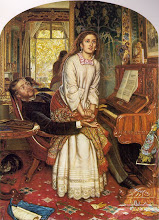1. For about two weeks after the first day of school, the route my son and I walk took us past a dead squirrel lying in the street, close to the curb. It was near someone's driveway, and looked as though it had died in great agony. "Look!" my son gasped, seeing it before I did that first day. I tried to conceal my nauseated cringe, and we talked about it. In fact, we had many opportunities to talk about it, because the squirrel remained, gradually deflating and decomposing, day after day. In the morning, my son insisted on going up a different street, so as to save the fascinating dead-squirrel nature observations for the way home. "Don't look up that street," he would caution me as we walked to school, but on the way home he would eagerly examine the squirrel's current state of decay. I called the city sanitation department two or three times, but the squirrel remained.
Then one day last week, my son, inspired by the wonderful out-of-print Margaret Wise Brown book The Dead Bird, asked me to make a sign to commemorate the squirrel. One one side, the sign was to read: "Here Lies A Squirrel That Is Dead," and on the other side: "Here Lies A Squirrel Which Is Dead." So I did, on a piece of cardboard with Sharpie marker, and on the way to school the next day we detoured past the dead squirrel and laid the sign in the street alongside it.
A day or two after that, the squirrel was gone, though, if you scan the gutter carefully, you can see a couple of bedraggled tufts of gray fur. The sign remained for another week, and now it is gone too.
2. The school is about three-quarters of a mile from our house, and the walk takes us down a lovely divided street with stately homes. Walking home alone one day, I noticed that, in back of one of these houses, a labyrinth had been painted on the driveway blacktop. I remembered when I worked at a Wall Street law firm for my day job, and how a church down there -- was it Trinity Church? -- installed a similar labyrinth, white lines painted on black canvas stretched out in the church courtyard. It was a very troubled time in my life, and I thought that walking the labyrinth during my lunch hour would somehow help. I would walk that flat, painted maze in the church courtyard, car horns blaring outside on the street, without knowing what feelings or insights it was supposed to inspire, and, to my knowledge, it didn't inspire any.
3. I learned recently to my dismay that the accomplished, attractive college-age daughter of a musician colleague whom I greatly respect has developed a serious heroin habit. Instead of taking her daughter back to school, my friend pulled her out of a sordid crack-house and drove her to an out-of-state rehab, and the daughter is now living in an out-of-state halfway house. My friend has no desire to go and see her.
This made me think about how my friend's music always seemed to come before everything else. She spends many months of every year on the road, and this family crisis has not slowed her down. If anything, I imagine that she is barricading herself ever more tightly into the predictable world of practice, rehearsal, and performance. This is an impulse I fully understand, for, where the world is broken, music is sound and whole, and where I am utterly powerless and ineffectual in my own life and the lives of others, I have always been able to feel a sense of power and agency in my art -- the ability to perform on a relatively high level and, in so doing, to move hearts. And, where the people I knew disappointed me, Brahms and Mozart did not -- could not.
The world is broken, nonetheless, and music cannot fix it. I wonder how often music becomes a substitute for what it stands for -- real love, true human connection.
Thursday, September 29, 2011
Quick Takes: Nostographers' Back-to-School Edition
Subscribe to:
Post Comments (Atom)












No comments:
Post a Comment